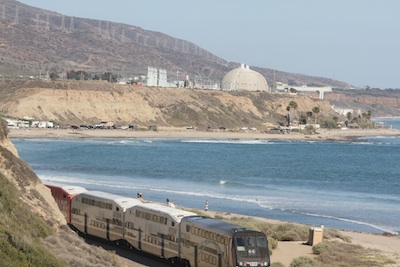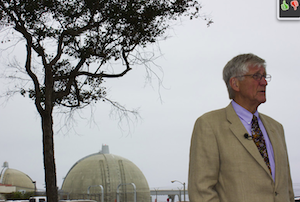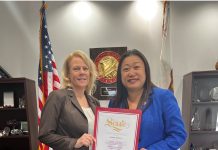By Rita Robinson and Andrea Adelson| LB Indy
 The San Onofre Nuclear Generating Station near San Clemente won’t be restarted again, but it will be years before its distinctive double domes disappear from the coastline.
The San Onofre Nuclear Generating Station near San Clemente won’t be restarted again, but it will be years before its distinctive double domes disappear from the coastline.
“It doesn’t happen overnight,” said Edison spokeswoman Maureen Brown, describing a years-long process decontaminating and deconstructing the plant under supervision of the Nuclear Regulatory Commission. Once ceasing operation, the utility is required within two years to file a decommissioning plan, which must be completed within 60 years, according to the NRC’s website. The expected tab is $4 billion, Brown said.
Money to fund the nuclear power plant’s dismantling began trickling into a fund from its first day of operation 40 years ago from customers, including residents in Laguna Beach and Newport Beach. Edison’s share now stands at $2.7 billion, she said, with the remainder contributed by the plant’s other co-owners, San Diego Gas and Electric and the city of Riverside.
Anti-nuclear advocates are shifting their concerns to the 1,400 tons of nuclear waste, known as spent fuel, being stored at the Edison plant, located just above the renowned San Onofre surf break.
“A thimbleful of plutonium could take out San Clemente,” said Gary Headrick, co-founder of San Clemente Green, a grassroots advocacy group that pressed for San Onofre’s closure. Some anti-nuclear advocates gathered on the frontage road at the plant after last Friday’s surprise announcement. “To think we have 1,400 tons of it here is a much bigger threat.”
The shutdown announcement by Edison, operator of the, came just three days after the former prime minister of Japan, Naoto Kan, publicly denounced the use of nuclear power at a press conference in San Diego. Kan, in office during the Fukushima meltdown, and former U.S. Nuclear Regulatory Commission chairman, Gregory Jaczko, were among five panelists speaking out against nuclear power.
“I have a great sense of relief. The more knowledge I had about San Onofre, the clearer it became that it shouldn’t start under any circumstances,” said Toni Iseman, a member of Laguna Beach’s City Council, which joined several cities in raising safety questions about Edison’s intent to restart the plant.
While Edison said uncertainty over bearing more financial costs drove its decision, Iseman pointed out Laguna and surrounding areas also faced an economic threat from the plant’s continued operation. “If Edison had another event, what would that do to tourism in Laguna?” she asked. “It was a risk we couldn’t afford to have.”
Iseman said she wrote a letter to the NRC, arguing about the risks of restarting San Onofre, which has the industry’s worst safety record. “Why choose to jeopardize the whole industry by turning it back on?” Iseman said she asked in her correspondence with regulators.
San Onofre was shut last year after a radiation leak from a worn tube that was part of a replacement steam generator installed in 2010. Anti-nuclear advocates Friends of the Earth contended that the new steam generator constituted grounds for a license review, a process that would have opened up the installation to a full investigation and public input. The Atomic Safety and Licensing Board, an arm of the NRC, agreed. The ruling created further uncertainty about restarting the plant.
“I didn’t think Edison would throw in the towel so early,” said Arnie Gunderson, a former nuclear industry engineer and author of a critical report about San Onofre released by Berkeley-based Friends of the Earth. Gunderson, who says he receives reports from whistleblowers at plants all over the country, receives more critiques from San Onofre workers than anywhere else.
Gunderson said it takes about two years for ocean water near a nuclear power plant, which uses the water to cool the generators and is then returned to the ocean, to reach safe levels of lower contamination. The sea water at San Onofre hasn’t been used at the plant for a year and a half.
“The easy part is over,” said Gene Stone of Residents Organized for a Safe Environment. “We have a lot of work ahead of us to make sure it’s decommissioned properly to make sure the federal government, the NRC and the state regulators come together to decommission San Onofre in the best way possible for the citizens. There’s no way in the world that we are going to allow this nuclear waste dump for 200 years.”
Gunderson said he expects the domes at San Onofre will be gone within 10 years. “It’s a big demolition project,” he said.
“It’s premature to speculate about potential reuse,” Edison’s Brown said. “Just as we’ve been committed to the safe operation of San Onofre, we’re also committed to its safe decommissioning,” she said, which will also include public hearings.





[…] Beach Independent – Domes Will Remain Intact for Years – Rita Robinson and Andrea […]